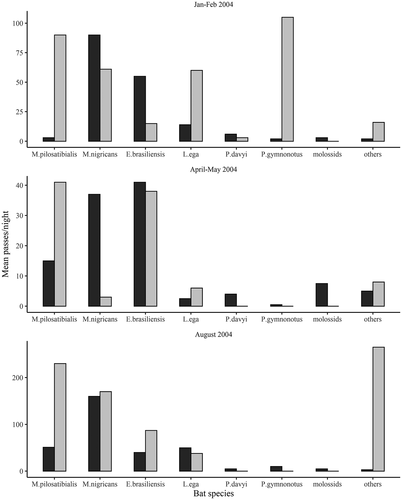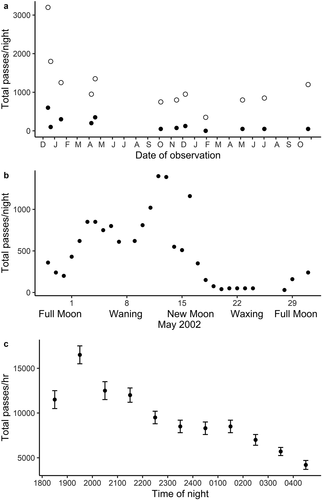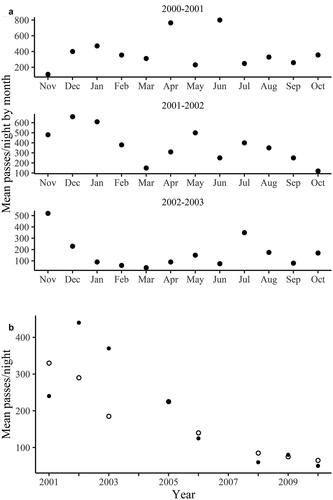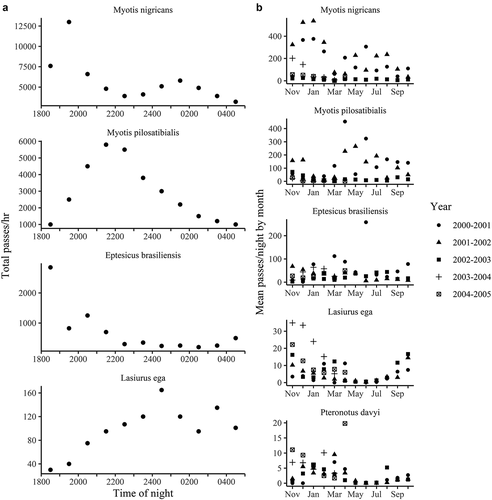Figures & data
Figure 1. Bat activity by species at Monteverde in the Cordillera de Tilarán, Costa Rica, at the Primary Sampling Site (dark bars) and at Selvatura (pale bars) during three periods (January and February, April-May, and August) during 2003–2004. From the left species are Myotis pilosatibialis, Myotis nigricans, Eptesicus brasiliensis, Lasiurus ega, Pteronotus davyi, and Pteronotus gymnonotus.

Table 1. Stepwise construction of the multiple logistic regression model of factors influencing the likelihood of Myotis nigricans presence at the Monteverde study site. For the first and second model n = 2836, for the subsequent models n = 2685. Standard errors of the coefficients and odds ratios are in parentheses. MOON_1 is when the moon is in the first quarter, MOON_2 is around the full moon, MOON_3 is in the third quarter, all relative to nights around the new moon. RAIN_1 and RAIN_2 are no rain, and light rain, respectively, relative to moderate rain. WIND_1 and WIND_2 are calm and variable winds, respectively, relative to windy conditions. N_PART_1 are the first four hours of the evening, N_PART_2 are the hours between 10pm and 2am, both relative to the hours between 2am and Dawn. SEASON_1 is the windy-misty season (1 Nov −15 Jan), SEASON_2 is the dry season (16 Jan-10 May), both relative to the rainy season (11 May-31 Oct). MYOPIL is for a increase of one pass of Mysotis pilosatibialis. See the discussion of analyses in Results for details of interpretation
Table 2. Stepwise construction of the multiple logistic regression model of factors influencing the likelihood of Myotis pilosatibialis presence at the Monteverde study site. For the first and second models n = 2696, for the subsequent models n = 2685. Standard errors of the coefficients and odds ratios are in parentheses. Independent variables as described in . MYONIG is Myotis nigricans present relative to M. nigricans absent
Table 3. Stepwise construction of the multiple logistic regression model of factors influencing the likelihood of Eptesicus brasiliensis presence at the Monteverde study site. For the first model n = 2847, for the second and third n = 2696, and for subsequent models n = 2685. Standard errors of the coefficients and odds ratios are in parentheses. Independent variables as described in . MYONIG is Myotis nigricans present relative to M. nigricans absent
Figure 2. Effects of wind, phase of moon, and time of night on bat activity at the Primary Sampling Site at Monteverde in the Cordillera de Tilarán, Costa Rica. All species combined. A. Bat activity on paired windy (open circles) and calm (filled circles) nights during the 2001–2002 year. B. Bat activity during the April-May, 2002 lunar cycle. C. Mean hourly bat passes (± one st. dev.), for all nights combined during the 2001–2002 year

Figure 3. Differences in bat activity among years at the Primary Sampling Site at Monteverde in the Cordillera de Tilarán, Costa Rica. A. Monthly mean bat passes per night, all species combined, for three years (2000–2001, 2001–2002, and 2002–2003). B. Decline in bat activity, all species combined, for the rainy season months of July (filled circles) and August (open circles) from 2001 to 2010

Table 4. Bat activity on rainy (but not misty) nights in 2001 and 2002 at the Primary Sampling Site at 1350m in Monteverde in the Cordillera de Tilaran, Costa Rica
Figure 4. Effects of time of night, season, and year on the activity of the most common insectivorous bats species at the Primary Sampling Site at Monteverde in the Cordillera de Tilarán, Costa Rica. A. Bat activity by time of night for four common species of bats (Myotis nigricans, M. pilosatibialis, Eptesicus brasiliensis, and Lasiurus ega) during 2001–2002, as indicated by number of passes per hour. Note differences in y-axis scales. B. Bat activity (mean passes/night) by month during five years for the five most commonly detected bat species (Myotis nigricans, M. pilosatibialis, Eptesicus brasiliensis, Lasiurus ega, and Pteronotus davyi)

